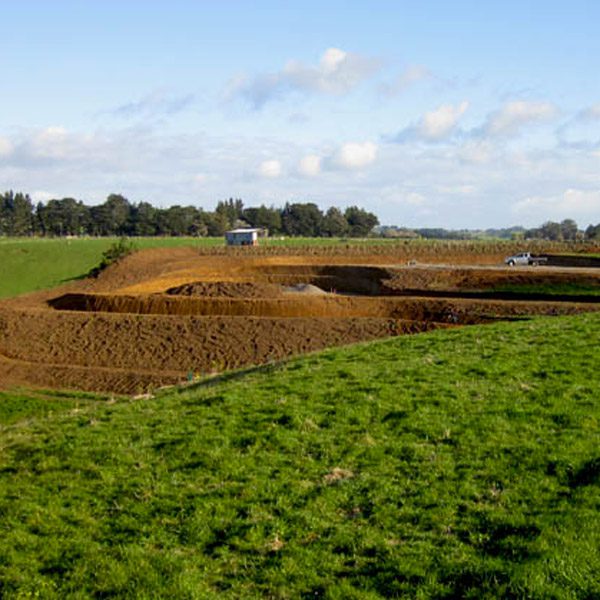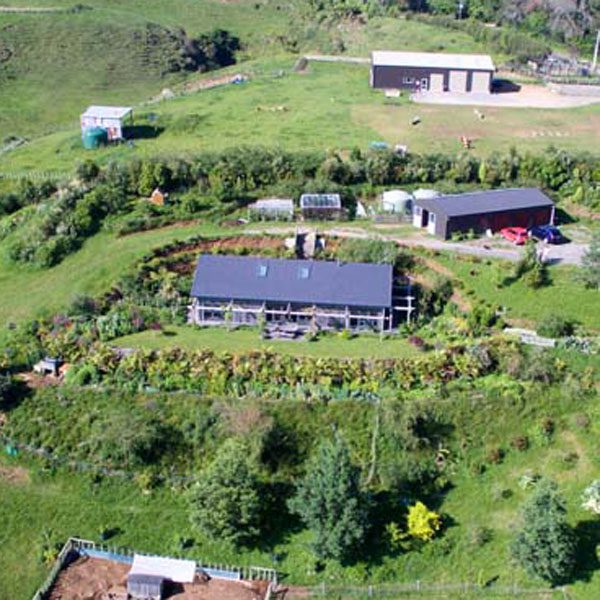Planning Your Lifestyle Block – Start with a healthy landscape

This site had three good house sites, and the clients chose the most dramatic one. The earthworks and terracing makes the site functional, helps soak water into the landscape, and reduces erosion.
When you are planning your lifestyle block, look for the patterns in the landscape … and then the site will almost design itself, writes Kama Burwell.
When designing a lifestyle block or farm, I always start with the basics: creating a healthy landscape where lots of water is stored in the ground, springs are restored, and waterways are clean, productive, and not suffering erosion. A healthy landscape is both droughtproof and less flood-prone, and is very productive and resilient. Sadly, little of the NZ landscape is any of these … so some of the ideas here may be new and surprising.
Get yourself several copies of an aerial photo of your site with contour lines (talk to your local council), and start drawing with a broad brush…
Start with siting your forests. Ideally, all the hilltops, ridges, and steep slopes need to be forested. Think of it as ecological infrastructure. Forests on these parts of the landscape do heaps of good things, including soaking lots of rain into the ground high up on your site, recharging groundwater, and seeping down to benefit the rest of the landscape. It doesn’t really matter what sort of forest: native, exotic, treecrops, firewood coppice, orchard, or food forest are all fine, although avoid large-scale plantings of eucalypt, kauri, or native beeches, as these tend to reduce the productivity of landscapes.
Consider foresting most of your lifestyle block… A 10 acre block is a biigg area, and putting most of it into regenerating forest, or into high-value multi-species forestry is a really good idea that can reap financial rewards as well as restoring the health and beauty of the landscape.
The best spots for houses are high in the landscape (but not at the top of the hill), get all day winter sun, and are sheltered from prevailing winds. Here, wastewater from your house can be soaked into the ground as high as possible, to support productive plantings and benefit the wider landscape by recharging groundwater.
Consider sharing your block with other households using a cross lease or unit title arrangement. This can massively reduce the cost and time burden of developing a lifestyle block, whilst adding fun! Design your decision-making and getting-out structures from the start, to make it workable.
Work along the contour as much as possible. Driveways, fences, tree rows, and footpaths all work better and support healthy landscape processes when laid along the contour. If driveways can’t go along the contour, then along ridgelines also works well. Sometimes neither is feasible, and designing for your stormwater runoff becomes very important.
Embrace wet landscapes and plug up any drains. A high water table doesn’t mean the land is useless for anything except native plants. In fact, the wetter the landscape, the more productive it can be. Outside the western/anglo cultures, wetlands are prized as places that grow the most food: think rice paddies with fish, mussels, frogs, and edible snails (very gourmet). Whilst creating a rice paddy is probably a bit daunting to most kiwis, the wetter areas of your site are great places for ponds, ducks, koura, taro, edible ginger, bananas, and arrowroot. If you are lucky, perch will colonise your pond, providing a delicious eating fish.
Don’t convert any existing vegetated wetlands into food production. Instead, it is likely your site has a paddock that is actually a drained wetland (it is usually easy to tell, just look for the drain), that you can un-drain and put to good use. Regardless, filling in any drains on your site will help restore groundwater levels, which are essential to a resilient and productive landscape.
Have a good hard think about whether you really need grazing animals such as cows, horses, goats, and sheep. These hard hoofed animals reduce the resilience and productivity of landscapes, mostly by compacting soils and damaging the living bio-seals that should line springs, wetlands, and waterways. And, they are a very inefficient way to grow meat – consider rabbits, guinea pigs, penned pigs, chooks, ducks, and guinea fowl instead…
If you love horses, or you must have your beefies, or a house cow for milk, then don’t despair… there are ways to do pastoral farming that aren’t so bad… (more on that in a future article). For now, the basics are to reduce their numbers, locate their pastures high in the landscape on flatter ground, provide housing for wet weather, move them very frequently, and keep them at least 20m from any spring, wetland, or waterway.
Good shelterbelts are critical if you want to grow food. In Taranaki, grow a wide, multi-species shelterbelt of at least 3 rows along the western, southern, and eastern boundaries of your site, with extra shelterbelts protecting house sites, tree crops, and other areas as needed.
Once you’ve applied all these basic patterns to the aerial photo of your block, you’ll have a strong spatial framework to work within. Now you can site your treecrops, orchards, food forests, gardens, and integrate your chooks and ducks to support them.
Kama Burwell is an ecological engineer and landscape designer, and is part of the GreenBridge team. She “lifestyled” for 9 years on a corner of the family farm near Inglewood, before moving to a suburban garden in New Plymouth.
www.greenbridge.co.nz.


